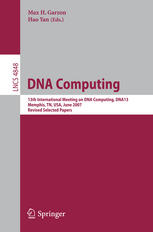

Most ebook files are in PDF format, so you can easily read them using various software such as Foxit Reader or directly on the Google Chrome browser.
Some ebook files are released by publishers in other formats such as .awz, .mobi, .epub, .fb2, etc. You may need to install specific software to read these formats on mobile/PC, such as Calibre.
Please read the tutorial at this link: https://ebookbell.com/faq
We offer FREE conversion to the popular formats you request; however, this may take some time. Therefore, right after payment, please email us, and we will try to provide the service as quickly as possible.
For some exceptional file formats or broken links (if any), please refrain from opening any disputes. Instead, email us first, and we will try to assist within a maximum of 6 hours.
EbookBell Team

5.0
38 reviewsBiomolecular/DNA computing is now well established as an interdisciplinary field where chemistry, computer science, molecular biology, physics, and mathematics come together with the common purpose of fundamental scientific understanding of biology and chemistry and its applications. This international meeting has been the premier forum where scientists with different backgrounds and a common focus meet to present their latest results and entertain visions of the future. In this tradition, about 100 participants converged in Memphis, Tennessee to hold the 13th International Meeting on DNA Computing during June 4–8, 2007, under the auspices of the International Society for Nanoscale Science, Computation and Engineering (ISNSCE) and The University of Memphis. The call for papers encouraged submissions of original, recent, and promising experimental and theoretical results in the field. The Call for Papers elicited some 62 submissions, almost perfectly balanced among the major theoretical and experimental categories. It is evidence of how well the interdisciplinary nature of the conference has truly matured that the major criterion of quality, agreed upon in advance by the Program Committee (PC), produced a nearly balanced program as well across the two major categories, full papers and talks with an abstract only. The program with the greatest perceived impact consisted of 24 papers for plenary oral talks; in addition, 15 full-paper posters and 10 poster abstracts were accepted, of which 5 authors were invited to give five short demos in a new submission category this year. The conference program retained the structure now customary for this meeting.